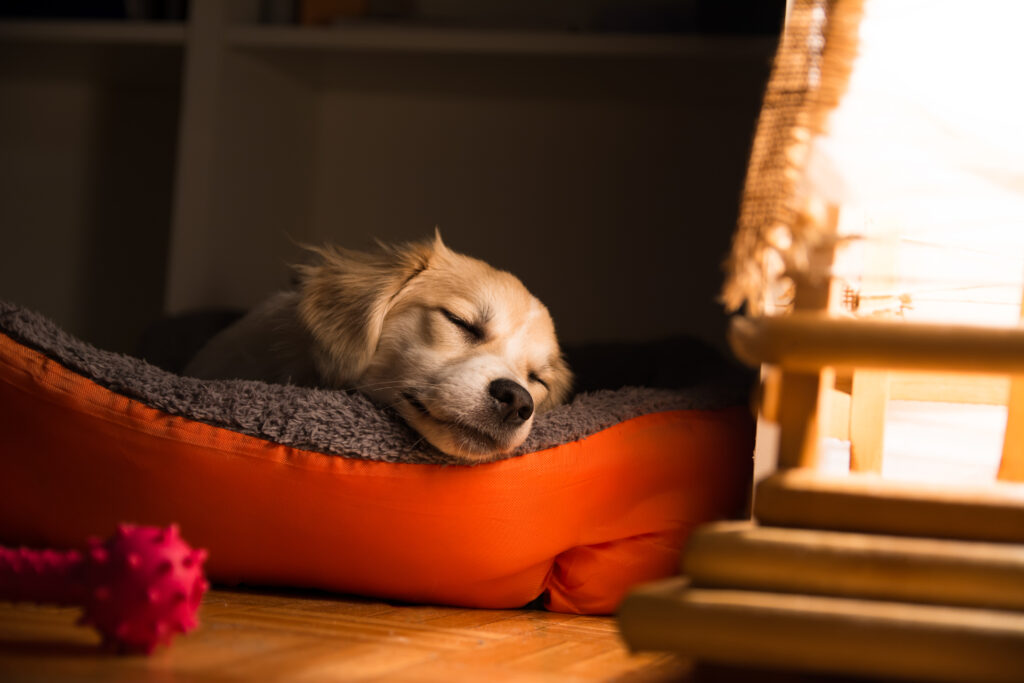Where you place your 8-week-old puppy at night plays a key role in ensuring they feel secure, sleep well, and adapt to their new home.
Here’s how to decide on the best sleeping setup and help your puppy feel comfortable…
Start with a Crate or Designated Sleeping Area
A crate or enclosed area is an excellent option for a puppy because it…
- Provides Safety – Prevents the puppy from getting into dangerous situations, such as chewing electrical cords.
- Creates Boundaries – Helps with house training by encouraging the puppy to hold their bladder until taken outside.
- Offers Comfort – Becomes a secure, den-like space where your puppy feels safe.
Recommended Setup
- Crate in Your Bedroom
- Place the crate in your bedroom or close to your sleeping area during the first few weeks.
- Being near you helps the puppy feel secure and less anxious in their new environment.
- You’ll be able to hear when they need to go out during the night.
- Use Soft Bedding
- Line the crate or sleeping area with comfortable, washable bedding. Avoid anything too bulky the puppy could chew and swallow.
- Include a Familiar Smell
- Add a blanket or item with their mother’s scent, if available, to provide comfort.
- Keep It Cozy
- Consider a puppy-safe heating pad or a heartbeat simulator to mimic the warmth and sounds of their littermates.
Create a Potty Routine
An 8-week-old puppy likely won’t sleep through the night without needing to relieve themselves. To help manage this…
- Take the puppy outside for a potty break right before bedtime.
- Be prepared to wake up once or twice during the night to let them out. Set an alarm to take them out before they wake up and have an accident.
Gradual Transitioning
If you plan for the puppy to sleep elsewhere eventually (e.g., in the kitchen or living room), start them near you for the first few weeks, then gradually move the crate to the desired location.
Avoid Common Mistakes
- Don’t Let the Puppy Roam Freely
- They could chew on hazardous items or have accidents. Puppies thrive with structure.
- Avoid Isolating Them Entirely
- If the puppy is placed in an entirely separate area, they might become distressed and cry excessively. A transitional setup closer to you will help.
Alternative Options (if Crate-Training Isn’t Preferred)
- Use a puppy pen – This provides more room than a crate but still limits their movement and ensures safety.
- Set up a puppy-safe corner in a room using baby gates. Include bedding, toys, and potty pads if needed, though these can delay house training.
Nighttime Tips
- Keep Calm During Wake-Ups
- If your puppy cries in the middle of the night, stay calm and avoid fussing over them. Take them outside to potty quietly and return them to their sleeping area.
- Stick to a Consistent Routine
- Puppies thrive on structure. A predictable nighttime routine helps them settle faster.
- Comfort But Don’t Spoil
- While it’s okay to reassure your puppy, avoid bringing them into bed if it’s not part of your long-term plan. It’s easier to establish habits early rather than changing them later.
For an 8-week-old puppy, the ideal sleeping arrangement is a crate near your bed to provide safety, comfort, and reassurance during their transition to your home. Gradually work toward their permanent sleeping setup as they grow older and adapt. With a consistent routine and care, your puppy will soon settle into a happy and secure nighttime routine.


